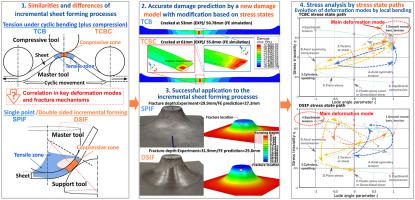International Journal of Machine Tools and Manufacture ( IF 14.0 ) Pub Date : 2022-11-22 , DOI: 10.1016/j.ijmachtools.2022.103980 Wenxuan Peng , Hengan Ou

|
This study investigates the deformation and fracture mechanisms of two testing methods, tension under cyclic bending (TCB) and tension under cyclic bending plus compression (TCBC) and their relationship to single point (SPIF) and double-sided (DSIF) incremental sheet forming processes. Experimental tests were carried out by using a bespoke TCBC test rig and a DSIF machine with grade 1 pure Ti samples. The results show the elongation-to-fracture has a high relevance to the bending depth and compression, which leads to detailed investigation to the stress and strain evolutions in the local bending region using finite element (FE) method. A new Gurson-Tvergaard-Needleman (GTN) model is proposed with a modified shear damage mechanism utilising experimental fracture strain loci to calibrate the Lode angle effect under low stress triaxiality. It is found the bending and reverse-bending stages correspond to different stress states and significantly affect the fracture occurrence in TCB, TCBC and SPIF, DSIF processes. For the first time, the stress paths in the plane of stress triaxiality and Lode parameter are used to reveal the transition of deformation modes from equi-biaxial to plane strain tension in SPIF and DSIF, as compared to the plane stress tension in TCB and TCBC. Using the new GTN model, the simulation gives accurate predictions to the elongation-to-fracture in TCB and TCBC, and the fracture depth in SPIF and DSIF with an error of less than 8% in comparison to the experimental results. Although there is a distinction between the equi-biaxial and uniaxial tension deformations, the study concludes that the TCB and TCBC tests provide an insight into the formability improvement and represent intrinsic deformation mechanisms of SPIF and DSIF processes, an ongoing research question, which has drawn considerable attention in recent years.
中文翻译:

循环弯曲加压、单点和双面增量板材成形过程中的变形机制和拉伸断裂
本研究调查了两种测试方法的变形和断裂机制,循环弯曲拉伸 (TCB) 和循环弯曲加压缩拉伸 (TCBC) 及其与单点 (SPIF) 和双面 (DSIF) 增量板材成形工艺的关系. 实验测试是通过使用定制的 TCBC 测试台和带有 1 级纯 Ti 样品的 DSIF 机器进行的。结果表明断裂伸长率与弯曲深度和压缩高度相关,这导致使用有限元 (FE) 方法对局部弯曲区域的应力和应变演变进行了详细研究。提出了一种新的 Gurson-Tvergaard-Needleman (GTN) 模型,该模型具有改进的剪切损伤机制,利用实验断裂应变位点来校准低应力三轴度下的 Lode 角效应。发现弯曲和反弯曲阶段对应于不同的应力状态,显着影响 TCB、TCBC 和 SPIF、DSIF 过程中的断裂发生。与 TCB 和 TCBC 中的平面应力张力相比,应力三轴度和 Lode 参数平面中的应力路径首次用于揭示 SPIF 和 DSIF 中变形模式从等双轴到平面应变张力的转变. 使用新的 GTN 模型,模拟可以准确预测 TCB 和 TCBC 的断裂伸长率,以及 SPIF 和 DSIF 的断裂深度,与实验结果相比误差小于 8%。尽管等双轴和单轴拉伸变形之间存在区别,











































 京公网安备 11010802027423号
京公网安备 11010802027423号